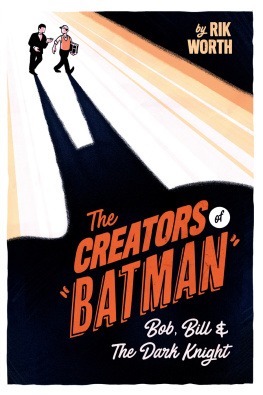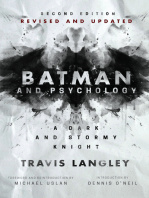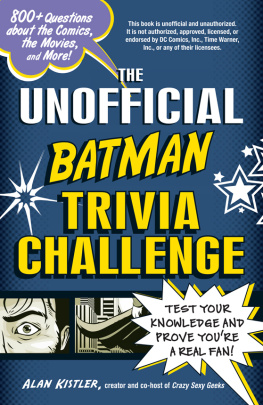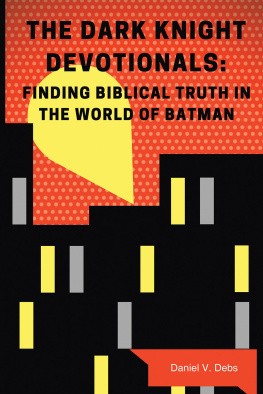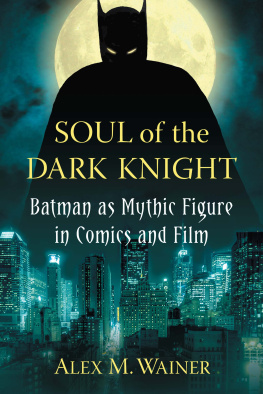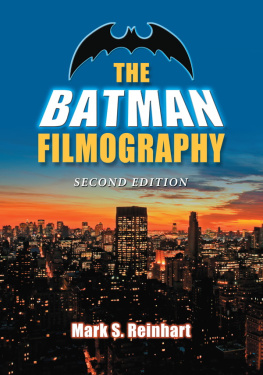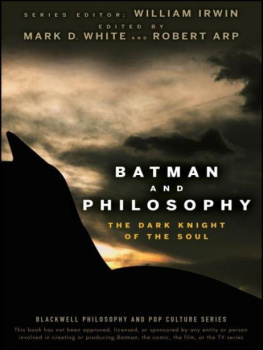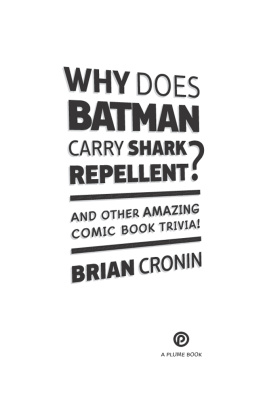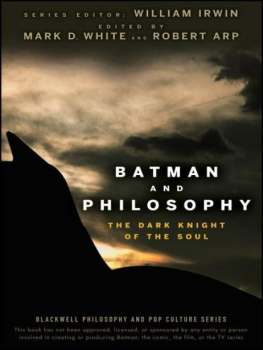Pagebreaks of the print version

THE CREATORS OF BATMAN
Dedicated to all my co-creators, co-conspirators, collaborators, co-workers, covens, congregations, cohorts, comrades, and companions past and present. It wouldnt be as fun to do this alone.
With special love for Beth, who gave me the courage to leap and the support to fly.
THE CREATORS OF BATMAN
BOB, BILL AND THE DARK KNIGHT
RIK WORTH
First published in Great Britain in 2021 by
PEN AND SWORD WHITE OWL
An imprint of
Pen & Sword Books Ltd
Yorkshire - Philadelphia
Copyright Rik Worth, 2021
ISBN 978 1 52677 761 4
eISBN 978 1 52677 762 1
Mobi ISBN 978 1 52677 763 8
The right of Rik Worth to be identified as Author of this work has been asserted by him in accordance with the Copyright, Designs and Patents Act 1988.
A CIP catalogue record for this book is available from the British Library.
All rights reserved. No part of this book may be reproduced or transmitted in any form or by any means, electronic or mechanical including photocopying, recording or by any information storage and retrieval system, without permission from the Publisher in writing.
Pen & Sword Books Ltd incorporates the Imprints of Pen & Sword Books Archaeology, Atlas, Aviation, Battleground, Discovery, Family History, History, Maritime, Military, Naval, Politics, Railways, Select, Transport, True Crime, Fiction, Frontline Books, Leo Cooper, Praetorian Press, Seaforth Publishing, Wharncliffe and White Owl.
For a complete list of Pen & Sword titles please contact
PEN & SWORD BOOKS LIMITED
47 Church Street, Barnsley, South Yorkshire, S70 2AS, England
E-mail:
Website: www.pen-and-sword.co.uk
Or
PEN AND SWORD BOOKS
1950 Lawrence Rd, Havertown, PA 19083, USA
E-mail:
Website: www.penandswordbooks.com
Introduction
Comic book history is unusual. As a field, it is a mixture of cultural analysis, business studies, biography, and art criticism. And the term history is extensive. It ranges from the primordial and ancient to just moments ago. Essentially, it describes something that is not anymore. But more than that, History (with a capital H that is) to your average Joe is about important things, like politics and war and moon landings.
Comics, for the most part, have not been considered important for most of their existence. Outside their once small yet dedicated fandom they were disposable trash; important only to the deeply nostalgic and the, lets face it, slightly odd. Even within comics, though the creations were important in that they made important men money, the same wasnt assumed of the creators.
The last few decades have seen that change substantially. Comic books, like novels and talking pictures before them, once seen as a distraction from important art, have stopped being a subculture and become culture itself. Theyre starting to be taken seriously. Society, for better or worse, is finally catching up with those of us who have been engrossed with comics since we first cast our wide eyes across their Technicolor splendour. They are becoming important.
Though it has existed for almost as long as the medium itself, comic book history is no longer just obscure lore about colourful and wild characters (and the comics they make nyuk, nyuk).
It is the history of modern culture.
On the vast scale of human cultural expression and achievement, we are still incredibly close to the genesis of what we would come to recognise as comic books. Were still basking in the intense light generated by a big bang occurring in the early twentieth century.
And its fair to say this is thanks to superheroes.
The idea of the superhero as we recognise it is somehow distinct but similar to the folkloric legends and yet, they are not even 100 years old.
At the same time, were entering the period when although the light of the comic book boom still shines, the distant stars which started it all are already fading away. The men and women at the birth of the comics industry are all but gone.
It is now impossible for us to collect first-hand accounts from all those who were there at the beginning. All we have left are anecdotes from the second generation (who are themselves now reaching a venerable age), and whatever documents were able to scrounge to give us some clue as to what was happening behind the scenes in those formative days. There is also, of course, the body of work the great creators left behind.
What makes comic book history so interesting, focusing on the individuals who worked in and built the industry rather than the progression of their characters, are exactly the same things making the four-colour capers in the pages of the books so exciting. New York in the early twentieth century was a bustling metropolis of shining avenues and shadowed alleyways. Cultures and ideas were blending (and clashing) on the island city. A romanticised but realistically tough tenement life, which housed many the industrys earliest creators, was home to heroes and villains alike, each with their own agenda, schemes and dreams.
As they built this new world of comics the creators became characters themselves, identifiable by their unique abilities, as their individual adventures weaved together towards some common goal. Idealistic underdogs faced Machiavellian machinations of the rich and powerful. Teams of creators formed and reformed with ever-changing rosters as characters dropped in and out of one anothers storylines, creating a pocket universe at once both real and fantastic. Like their caped characters, they frequently participated in crossovers, team-ups, and long-standing feuds. The only difference is that in reality, the good guys didnt always win.
No one knew what they were up against or what they were creating. For most, it was something fun to do while they waiting for a real job to come along. For others, the motivation was to make a bit of cash. When the comic book boom happened, only a few were savvy enough to see just how much money could be made from the funny books. Everyone else was just holding on and hoping they made it out in one piece.
The goings-on of an American fringe industry emerging in the New York borough of the Bronx during the 1930s is even more remote still if youre trying to document them from Englands dreary West Yorkshire in 2020.
To make matters worse, the creators of Batman, Bob Kane and Bill Finger are, to be polite, difficult subjects for two entirely contradictory reasons.
Kane, while confident and full of braggadocio is a deeply unreliable source, especially in details of his own life. Though he managed to make his way into the spotlight, what he presented to the world was an act; a performance in which, sometimes unintentionally and occasionally intentionally, the truth was bent, broken and twisted to make a good story. What makes a good story? Well, one with Kane at the centre, of course.
Finger, for his part, was the opposite. Easy-going to the point of retiring. He was just grateful to be in the room. He was talented and likeable, and yet he was easy to forget, and subsequently, forgotten. It is only recently, thanks to the dedicated work of comics historians in America, that he has been brought back onto the stage.
What we know about these two men is incomplete, inconsistent and scattered among multiple sources. The goal of this book is to collate what we do know so that we can better understand the relationships, motives and lives of these two men.

